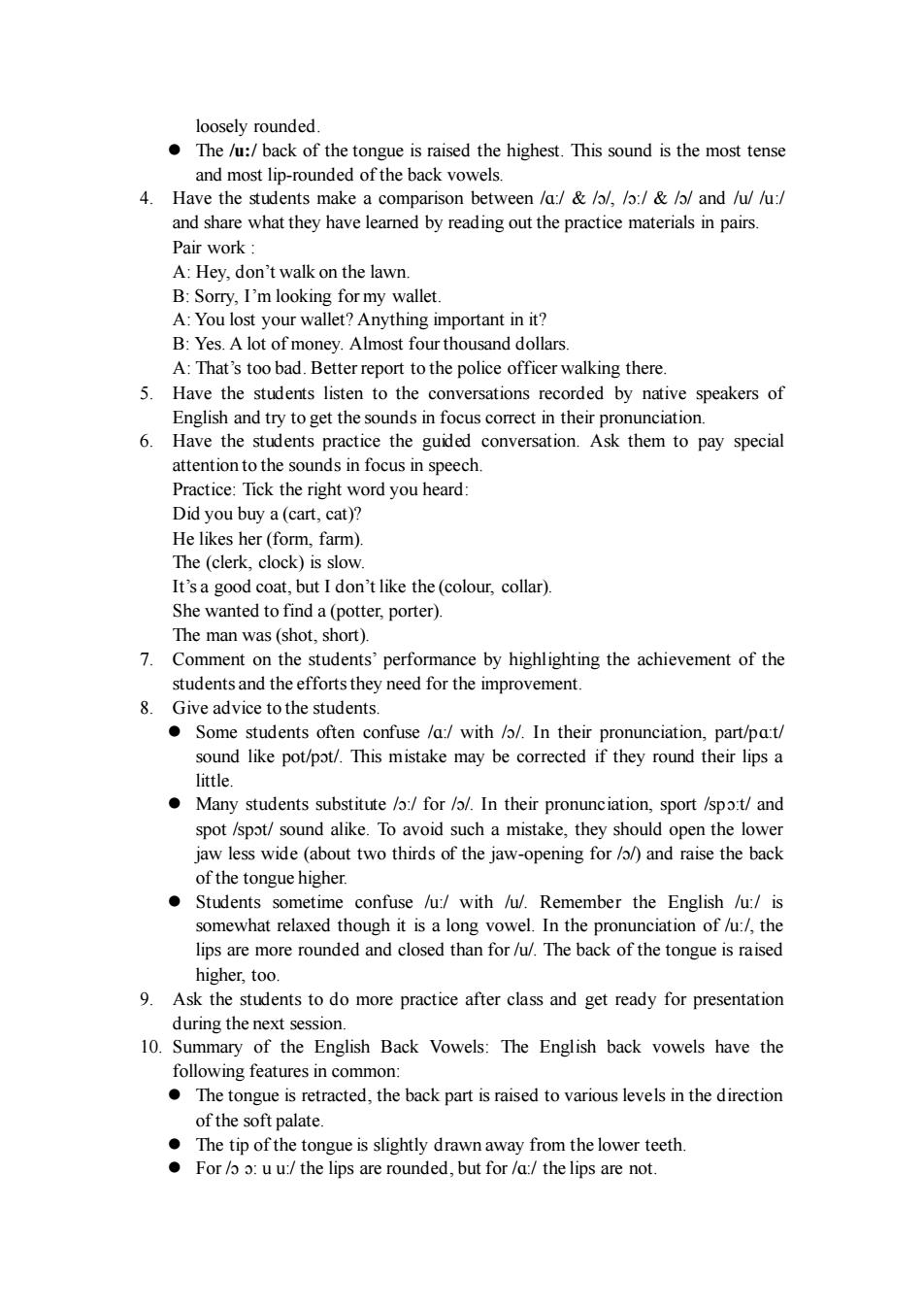正在加载图片...

loosely rounded 。The/a:/back of theto is raised the highest.This sound is the most tense and most lip-rounded ofthe back vowes 4.Have the students make a comparison between /a:/&//:/&//and /u//u:/ and share what they have leamned by reading out the practice materials in pairs. Pair work A:Hey,don't walk on the lawn B:Sorry,I'm lookin for my wallet A:You lost your wallet?Anything important in it? B:Yes.A lot of money.Almost four thousand dollars. A:That's too bad.Better report to the police officer walking there. 5.Have the students listen to the conversations recorded by native speakers of English and try to get the e sounds in focus in their Have the students practice the guled conversions 6. them to pay special attention to the sounds in focus in speech. Practice:Tick the right word you heard: Did you buy a(cart cat)? He likes her (for The (clerk,clock)is slov It's a good coat,but I don't like the (colour.collar). She wanted to find a(potter,porter). The man was (shot.short). 1. Comment on the students'performance e by highlighting the achievement of the students and the effors theyneed for the improvemen Give advice to the students o Some students often confuse /a/with //In their pronunciation.part/pat/ sound like pot/pot/.This mistake may be corrected if they round their lips a little ●Man students substitute:/for//In their spot /spt/sound alike.To avoid such a mistake,they should open the lower jaw less wide (about two thirds of the jaw-opening for //)and raise the back of the tongue higher. .Students sometime confuse /u:/with /u/.Remember the English /u:/is higher.too 9.Ask the students to do more practice after class and get ready for presentation during the next session 10.Summary of the English Back Vowels:The English back vowels have the following fea ures inc The tongue is retracted,the back part is raised to various levels in the direction of the soft palate. The tip of the tongue is slightly drawn away from the lower teeth. o For/o:uu/the lips are rounded.but for/a/the lips are not. loosely rounded. ⚫ The /u:/ back of the tongue is raised the highest. This sound is the most tense and most lip-rounded of the back vowels. 4. Have the students make a comparison between /ɑ:/ & /ɔ/, /ɔ:/ & /ɔ/ and /u/ /u:/ and share what they have learned by reading out the practice materials in pairs. Pair work : A: Hey, don’t walk on the lawn. B: Sorry, I’m looking for my wallet. A: You lost your wallet? Anything important in it? B: Yes. A lot of money. Almost four thousand dollars. A: That’s too bad. Better report to the police officer walking there. 5. Have the students listen to the conversations recorded by native speakers of English and try to get the sounds in focus correct in their pronunciation. 6. Have the students practice the guided conversation. Ask them to pay special attention to the sounds in focus in speech. Practice: Tick the right word you heard: Did you buy a (cart, cat)? He likes her (form, farm). The (clerk, clock) is slow. It’s a good coat, but I don’t like the (colour, collar). She wanted to find a (potter, porter). The man was (shot, short). 7. Comment on the students’ performance by highlighting the achievement of the students and the efforts they need for the improvement. 8. Give advice to the students. ⚫ Some students often confuse /ɑ:/ with /ɔ/. In their pronunciation, part/pɑ:t/ sound like pot/pɔt/. This mistake may be corrected if they round their lips a little. ⚫ Many students substitute /ɔ:/ for /ɔ/. In their pronunciation, sport /spɔ:t/ and spot /spɔt/ sound alike. To avoid such a mistake, they should open the lower jaw less wide (about two thirds of the jaw-opening for /ɔ/) and raise the back of the tongue higher. ⚫ Students sometime confuse /u:/ with /u/. Remember the English /u:/ is somewhat relaxed though it is a long vowel. In the pronunciation of /u:/, the lips are more rounded and closed than for /u/. The back of the tongue is raised higher, too. 9. Ask the students to do more practice after class and get ready for presentation during the next session. 10. Summary of the English Back Vowels: The English back vowels have the following features in common: ⚫ The tongue is retracted, the back part is raised to various levels in the direction of the soft palate. ⚫ The tip of the tongue is slightly drawn away from the lower teeth. ⚫ For /ɔ ɔ: u u:/ the lips are rounded, but for /ɑ:/ the lips are not